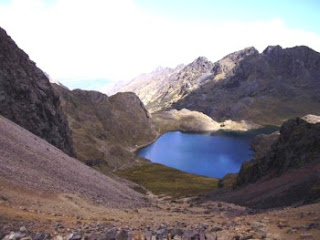You find heroes in the damnedest places.
I found one July 29, a hot Friday afternoon on Tiger Mountain, where the parasailers glide. On our previous Tiger Mountain Climb my friend, Terry, and I had hoped to see paragliders because he has 100 flights under his belt. But the weather was bad and none showed up. This time the sky was almost crowded with them.
My original reason for climbing Tiger Mountain was conditioning for Peru. But after the Rainier experience last week, I needed something lighter, and this was going to be fun.
In places, the trail up Tiger Mountain from the parasailing landing field on the Issaquah-Hobart road almost looks like it was laid out by a landscaper. There are places where irregular stones are positioned almost mosaic-like. There are virtual staircases of stone, and retaining walls that keep the banks from collapsing and keep the path even. That’s helpful for the parasailers, who pack their 45-pound loads of flying equipment up that path, ascending 1,700 feet in two miles. These guys (and an occasional woman) are tough, buff and adventurous.
Terry and I hiked the trail and were rewarded with a beautiful day and a sky full of fliers. Their photos are below. But one of the most memorable experiences for me happened on the descent, when I saw what I thought was an elderly man struggling on his knees on the trail. In fact, he WAS struggling – with a stone that I would have had trouble lifting. He was maintaining the trail – all by himself.
Here he is, accommodating my request to take his photo:
His name is Mike McKillop, owner of A+ Pest Control and A+ Structural Inspections. He lives in Carnation, and in his spare time he has maintained the trail that the parasailers and hikers climb to reach the summit of Tiger Mountain. Mike said he has 6,000 hours into trail maintenance. I mentioned him to people I passed on the way down, and two different parties affirmed that they knew of him from prior climbs.
Despite my curiosity, for some reason I failed to ask Mike why he maintains a route that’s likely used by hundreds if not thousands of people every year. I couldn’t detect an ounce of boastfulness. He’s gentle, friendly, and unassuming. He reminds me of a Vachel Lindsay poem:
The mouse that gnawed the oak-tree down,
When that tough foe was at his feet—
Found in the stump no angel-cake
Nor buttered bread, nor cheese, nor meat—
The forest-roof let in the sky.
“This light is worth the work,” said he.
“I’ll make this ancient swamp more light,”
And started on another tree.
When that tough foe was at his feet—
Found in the stump no angel-cake
Nor buttered bread, nor cheese, nor meat—
The forest-roof let in the sky.
“This light is worth the work,” said he.
“I’ll make this ancient swamp more light,”
And started on another tree.
If you have a hankerin’ to parasail, you can get in on a $50 savings on an introductory “tandem” flight Sunday, Aug. 28. Go to www.nwparagliding.com for details.
This could be you:

Love,
Robert
















































